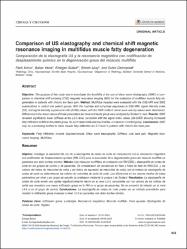Comparison of US elastography and chemical shift magnetic resonance imaging in multifidus muscle fatty degeneration

View/
Access
info:eu-repo/semantics/openAccesshttp://creativecommons.org/licenses/by-nc-nd/3.0/us/Date
2024Metadata
Show full item recordAbstract
The purpose of this study was to investigate the feasibility of the use of shear wave elastography (SWE) in comparison to chemical shift encoding (CSE) magnetic resonance imaging (MRI) for the evaluation of multifidus muscle fatty degeneration in patients with chronic low back pain. Method: Multifidus muscles were evaluated with the CSE-MRI and SWE
examinations in control and patient groups. With the in-phase and out-phase sequences in CSE-MRI, signal intensity index
(SII), and signal intensity suppression ratio (SISR) values; with the SWE method, shear wave velocity values were determined.
Differences in the mean values of these parameters per level and study group were analyzed by Student’s t-test. Results: SWE
revealed significantly lower stiffness at the L2-3 level, consistent with the signal index values (SII-SISR) showing increased
fatty infiltration on MRI in the patient group. No such relationship was found at the L4-5 level or in control group. Conclusions: SWE
may be a promising method to show muscle fatty infiltration at L2-3 level in patients with chronic low back pain.
Source
Cirugia Y CirujanosVolume
92Issue
5Collections
The following license files are associated with this item:


















